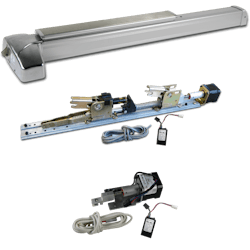We attend security conferences to see the latest products and get training in how to best use these products as we urgently try to envision the near and not so near future of security and controlling access for our customers.
Exhibitors from all over the world present their latest and greatest for inspection, consideration and purchase. Big companies, small companies and startups vie for our attention. For every component and method for security and controlling and limiting access, there are numbers of manufacturers offering their own interpretation and methodology.
We get to see some of the products in action and get excited about the new, improved and amazing. We must know if the products are compatible with existing systems or if not what is required to be compatible.
We look and think about these new products, and the products we use regularly. Talking with them, we hope to expand our knowledge base by being introduced to their products.
We look for trends in the market to help make major decisions. What appears to be an interesting trend is security professionals who have been installing wired systems for about twenty years or more are becoming more interested in wireless locks. And, security professionals who have been just installing wireless locks are expanding into wired products and installing different locking mechanisms. We appear to be trending in two directions, each positive for the end user.
We get to know about new products by word of mouth, subscribing to magazines, newsletters, organization memberships and other resources. Staying current is not good enough, we need to get a little ahead of the curve.
For most access control and security systems, there is no one company that provides all the components. You usually need to combine products from different companies to create the "best" systems for your customers.
The hardest part is there are so many different products and methods of implementation. Each manufacturer has their definition of security and how it is best implemented.
Command Access Technologies (CAT), a manufacturer and modifier of high quality electric locks, panic hardware and support components, has created their own line of power supplies, unique design power transfer products and innovative electronic modules that allow CAT products and just about every lock hardware manufacturer’s products to work together.
At a time when many manufacturers have cut back, Command Access has engineering and R&D departments improving and expanding upon methods for controlling access more efficiently with products such as the PM300 Series Power Booster Interface Modules.
The CAT PM300 supplies the necessary power surge for solenoid latch retraction at the door. It then electronically controls the current to keep the solenoid cool for the duration of the open cycle. This configuration enables a single power supply to be mounted up to 700 feet away with 18 AWG wire operating multiple solenoid latch retraction devices.
The PM300 includes high output mode to overcome job site conditions, such as heavy vertical rods and misaligned doors when used in conjunction with Command Access power supplies.
Locksmith Ledger recently caught up with Command Access Technologies President Greg Kristoff to get his take on what the future holds for the access control market.
LL: What direction is electronic security moving towards in 2013?
Kristoff: From our perspective, there seems to be a lot of excitement surrounding high tech system controls, credentials and wireless communications protocols including Z-Wave and Bluetooth. We believe these products will be yet another tool in the access control dealer’s bag.
LL: What new electronic products do you feel will revolutionize the security industry?
Kristoff: I believe that the driving force behind a revolutionary change in access control will be significantly lower cost per opening, easier to install systems and hardware, and simplified use for the end user. There is still a huge cost difference between a conventional lock and an access controlled opening that is part of a system.
LL: How does Command Access plan to address these revolutionary changes?
Kristoff: Our product development team continually strives towards time and cost saving solutions. Installation, troubleshooting, and system management costs are expensive. Our goal is to produce products that install easily, require minimal training, and work flawlessly well beyond our 3-year no hassle warranty.
LL: Will batteries play an ever increasing role in the development of electronic access control?
Kristoff: As credential solutions operate more and more efficiently with battery powered door hardware, I think there will be more practical options for their use. Battery powered door hardware to be practical needs to have sufficient power for a couple of years (in most conditions). This makes sense when trying to maintain communications, especially on an emergency level. The challenge is to extend battery life and reduce power draw, while providing more features and functionalities.
LL: Have wireless standalone locks affected your market share?
Kristoff: It is hard to tell. The wireless standalone systems are typically expensive, somewhat bulky, and not always preferred by architects. They certainly have their applications, but it is not always the best solution for the end user. I would be arrogant in stating that wireless standalone locksets have had no impact on wired lock sales. But, our year over year wires locks sales continue to grow and it should be noted that our products are also used in IP/POE and hybrid wired/wireless systems.
LL: What new products are being introduced by Command Access for 2013?
Kristoff: This year we will be introducing several exit device motor kits/modifications, new power supplies and an extra-heavy duty Grade 1 cylindrical lock.






